Contents
What to See in Northern Vietnam
Northern Vietnam is a picture book Vietnam at its best. This region is home to the rolling hills, misty mountain passes, emerald rice paddies and swishing palm trees of your imagination, with a cooler climate, and infinitely more complex ethnic diversity than almost anywhere else in Vietnam.
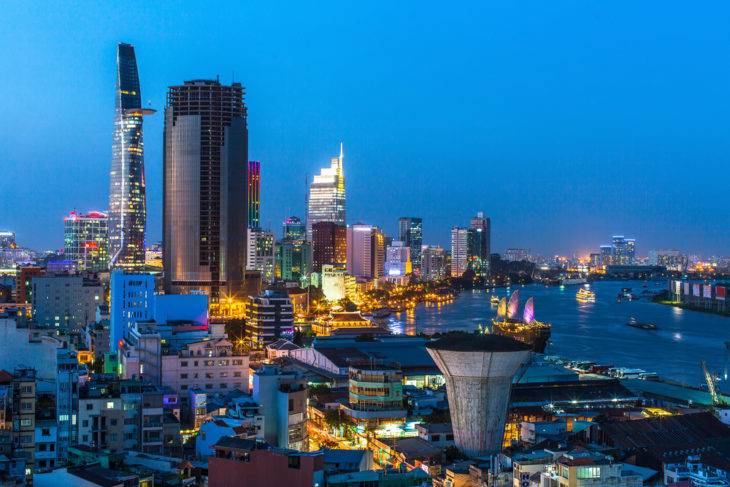
Source: shutterstock.com
Hanoi
Hanoi is Vietnam’s bustling, noisy, colorful and captivating capital city. Once the mysterious epicenter where few foreigners dared to tread, Hanoi is now geared towards being one of the tourism powerhouses of Southeast Asia, behind Hong Kong and Bangkok.
Hanoi is largely the cultural center of Vietnam, home to pho (the noodle-y national dish), grand embassies and government buildings. Vestiges of the city’s, and indeed the nation’s complicated history can be seen everywhere if you know what to look for. Ancient temples marked with Nôm characters sit next to crumbling French villas, opposite Max Mara’s and Hugo Boss. Life, culture and color can be found on every corner – it truly is a place not to be missed.
Best Bits – If you’re going to try pho, Vietnam’s national dish nowhere, it has to be in its birthplace, Hanoi. This savory, aromatic noodle-soup is beginning to breach the borders of Vietnam at an ever-expanding rate, and can now be found on high streets from Manchester to Melbourne and everywhere between. Cinnamon, ginger, cardamom and other spices are gently toasted to create the clear broth that pho is famous for, before tender slices of beef and silky rice noodles are added. Pho stall are literally everywhere in the city, and a proper bowl, to be enjoyed on a tiny plastic stool, will cost you as little as 30,000 VND ($1.2 US)
Halong Bay and Cat Ba
Just three hours from Hanoi lies the UNESCO World Heritage site of Halong Bay. Jagged, limestone peaks soar from the turquoise surf, which is known to bear some of the sweetest and freshest seafood in the world. Living in this dream-like paradise are ancient fishing villages, who now open their colorful settlements to curious visitors who want to see how they go about their daily lives.
Best Bits – Get on board on a traditional junk and see the bay close up. Scores of boat tour operators exist, and there is enough variety to suit any budget or occasion. Boat tours can be booked from travel agents in Hanoi, or from hotels, travel agents and indeed cafes and bars in both Halong and neighboring island Cat Ba, a burgeoning tourism destination located just across the bay from Halong. Prices can start at just 14 USD for the day, including lunch, to several hundred dollars for multi-day cruises aboard luxury vessels.
Mai Chau
Mai Chau is just four hours away from Hanoi, yet couldn’t be more different. This gorgeous, peaceful region has been home to traditional Vietnamese settlements for eons and has only just arrived on the Western tourism map of Vietnam. Imagine towering mountains, plunging valleys and scenic rivers, dotted with traditional stilt villages.
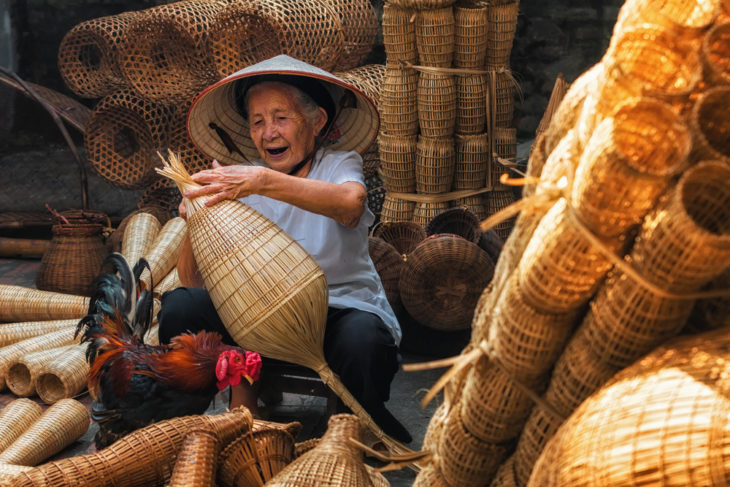
Source: shutterstock.com
Sapa
Sapa, in Vietnam’s mysterious and isolated northwest, is the region’s premier tourism destination. The town itself is small, and tourism is mushrooming haphazardly, resulting in an ever-increasing loss of what used to be a quiet, authentic, local atmosphere. However, no one travels to Sapa to stay in the town. A short cycle, a trek, or a bus away, you’ll find little slices of ancient Vietnam. Be it the nine local ethnic minorities, who punctuate the landscape with their colorful dress, or the staggering natural topography of rolling rice terraces and mountains, including Southeast Asia’s tallest – Fansipan, there’s a lot of exploring to be done. To get to Sapa, we recommend taking the train from Hanoi. It takes roughly eight hours, runs overnight and will drop you around 30 kilometers from Sapa town in Lao Cai. From here, you can take a private bus or taxi, though the public bus is cheap and reliable.
Ba Be
Ba Be is a national park situated 230 kilometers from Hanoi. It is often referred to as Ba Be lakes, owing to the fact that the entire national park is situated on the banks of its three large, clear lakes. The surrounding scenery is prehistoric; towering limestone cliffs give way to waterfalls and natural pools, and the park biodiversity of the foliage will make you feel like you’re wondering through Jurassic Park. Take a motorboat or a kayak and explore the magical lakes to your heart’s content. Buses run regularly from Hanoi’s Old Quarter to Ba Be and take between four and five hours.
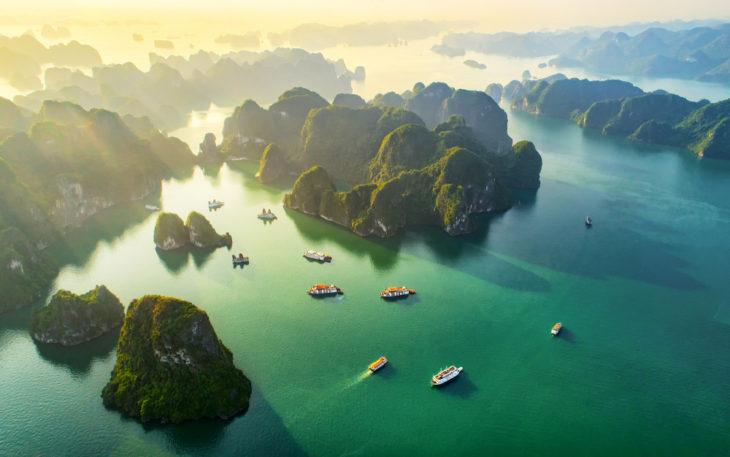
Source: shutterstock.com
What to See in Central Vietnam
Central Vietnam is arguably the nation’s culinary hotspot. Influences from the north and south of the country culminate here, with added influences from bordering Laos, Cambodia and Thailand. However, the food’s only half of it. Central Vietnam is surrounded by white-sand coast on one side, and rich, verdant forest on the other, much of which is crisscrossed by the famous Ho Chi Minh trail.
Da Nang
Danang was once little more than a stopover between the fascinating (and beautiful) ancient towns of Hue and Hoi An. However, today it stands as the country’s third largest city, behind Hanoi and Ho Chi Minh City and new life is being breathed into it in all directions. Situated on the coast, slap-bang in the center of the country, Da Nang is also increasingly heralded as the ultimate Vietnamese culinary destination, with an abundance of fresh seafood, a lively barbeque culture and a huge variety of local dishes. Danang is easily reached by bus or train from north or south, as well as via its large international airport.
Best Bits – A viral sensation and now a veritable tourism destination in itself, Da Nang’s latest bridge was one of the most viewed tourism videos in the entire month of June on the planet. Known as the Golden Bridge, this latest bridge stands 1,400 meters above sea level above the Ba Na hills just outside of the city, offering majestic views of the surrounding mountains and valleys. The gold walkway lined with flowers extends for almost 150 meters, appearing to be held up entirely by two enormous stone-look hands. It’s a must for those with social media account and Instagrams to be maintained!
Hoi An
Hoi An is easily Vietnam’s most beautiful old town, and that’s saying something. Dating back to the 15th century, Hoi An was originally a trading port, and its foreign influences can be seen clearly in its unique blend of architectural styles. Ornate Japanese bridges sit across from ancient temples, still in use today. Distinctively Vietnamese features sit upon French colonial townhouses – all culminating in this quirky, unusual and endlessly intriguing UNESCO World Heritage site. Hoi An is around an hour’s drive from Danang, reachable by bus, train, or private taxi.
Best Bits – There are so many excellent things to do in Hoi An. From visiting one of its clusters of award-winning beaches (known to have some of the cheapest and best day rates in all of Southeast Asia) to attending one of the country’s best cooking schools at Morning Glory, to take a romantic, lantern-lit boat ride up and down the town’s river. However, one thing you shouldn’t miss is the chance to have a garment tailored at one of the town’s expert tailors. Hoi An is famous for its huge range of artisan garment produces, and you’ll find countless stalls in and around the Old Town selling made to measure wedding dresses, suits, leather sandals, ao dai’s (traditional Vietnamese garments) and everything in between. Prices are exceptionally reasonable, and the tailors are some of the best in the world.
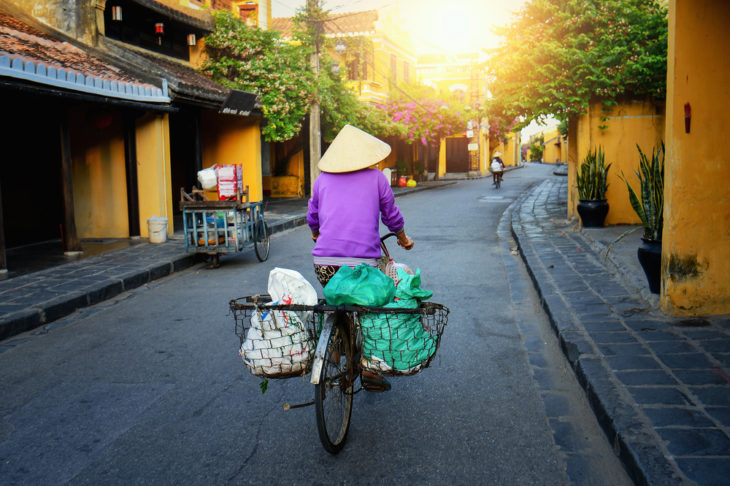
Source: shutterstock.com
Hue
One the nation’s imperial capital, the city’s faded excellence is indeed part of its charm, and increased tourism to the city has given birth to a new wave of badly needed regeneration; bars, hostels and travel agencies are rapidly popping up around the city. He is reachable via bus, or train from Danang, as well as Hanoi. From Hanoi, you can take the Reunification Express overnight to Hue, which takes around 10 hours.
Best Bits – No trip to Hue would be worth the gas in getting there without a visit to the imperial citadel. The crumbling walls and the towering central flag can be seen across the city; it is by far the most important attraction in the town. The sprawling citadel used to house the mighty Nguyen emperor and held the seat of power during the 19th century, until the invasion of the French protectorate in the 1880s. After that, it was still used but to carry out ceremonial traditions and ceremonies, until the monarchy was abolished altogether in 1945. It’s fate after this time was not so good, and it was largely neglected, as well as partially destroyed during cyclones and bombings. However, the Vietnamese government has spent great care in carefully restoring it in recent years (although the remaining crumbling walls, pocked with bullet holes, certainly add to the history of the place). The entire complex is well signposted, and walking tours are available.
Phong Nha
Phong Nha is an enormous national park and UNESCO World Heritage site located in central Vietnam. The park contains the oldest karst mountains in Asia, formed approximately 400 million years ago, as well as the world’s largest cave, with potentially hundreds more undiscovered. Phong Nha is easily accessible by train and bus from both northern and southern Vietnam (the closest big town would be Hue, one or two hours away), and makes for the perfect short break. Visitors can soak up the staggering natural landscape on two feet, two wheels (bicycles are readily available) and via kayak, on one of the many streams and rivers that pass through the caves.
What to See in Southern Vietnam
Southern Vietnam is Vietnam from the movies. Friendly people, gorgeous (if occasionally suffocating) weather, swaying palm trees and thick jungle. Remnants of the pivotal role the region played in both the French colonial era and the Vietnam war are scattered everywhere here, from the abandoned prisons of Phu Quoc to the impressive Cu Chi tunnels outside of Saigon. Aside from its painful history, Southern Vietnam is also home to some of the most beautiful beaches in all of Southeast Asia and is an absolute must for everyone visiting Vietnam.
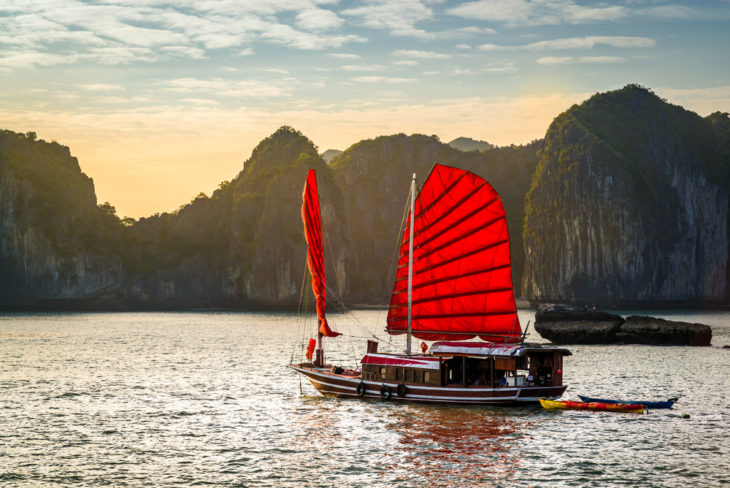
Source: shutterstock.com
Ho Chi Minh City
Known locally as Saigon, Ho Chi Minh City is Vietnam’s largest, most dynamic, and, if it’s even possible, noisiest. Colorful vendors and markets give way to soaring skyscrapers, Bahn mi (Vietnamese sandwich) carts sit in front of Starbucks and Dior, and ladies in conical grass hats peddle wares to tourists in elephant pants.
Ho Chi Minh City has been largely shaped by its recent political history, with vestiges of French and American occupations sitting, as opposed to Hanoi, right above the surface. The city is home to many colonial landmarks, such as the enormous, Gothic Notre Dame, built in the 19th century from materials imported solely from France.
Best Bits – The Cu Chi tunnels are a staggering network of underground passages that were used to transport goods, weapons, and people, during the war. Their sheer scale is enormous – 120 kilometers, and infinitely impressive, including trapdoors, living areas, kitchens, storage facilities, armory, hospitals, and command centers. However, try ascending one of the crawl spaces and you’ll see why they weren’t discovered by enemy troops- the entrances are so small and well concealed that few Westerners can squeeze through. Though, it is certainly entertaining to try. These days the actual tunnels have been cemented and widened to make it easier for tourists to pass through. Day tours run from Ho Chi Minh City and are around the 24USD mark.
Mekong Delta
The Mekong Delta is the vein that pumps blood to the entire region. This meandering causeway makes its plunge into the ocean in Southern Vietnam, ending 4,300-kilometres from its beginnings in the Himalayan plateaus of Tibet. Not only are the deltas dizzying greens worth a visit in and of themselves, but it’s the human interaction with the delta that makes for the biggest takeaway. Head to the larger towns and villages and you’ll see a flurry of activity – vendors and punters alike set upon rickety boats and buy and sell their daily wares.
Best Bits – Any hotel or travel agent in large cities, particularly in Saigon, will be able to assist you in booking a tour to the Mekong. Trips can be as short as an afternoon or as long as a few days, and can be as cheap or expensive as you make them. We recommend taking a tour with an English-speaking guide, as some of the best floating markets are difficult for foreigners to find, and you may miss out on interesting facts about the area without one!
Nha Trang
Nha Trang is fast becoming one of Vietnam’s premier holiday destinations. Favored by domestic tourists, Russians and tourists from various Asian countries, investment is pouring into Nha Trang at a rate of knots. And, the small city is starting to enter Western tourism maps – a long last. It is possible to get an overnight train from Ho Chi Minh City to Nha Trang, which usually takes around 12-20 hours, however, if you’re feeling slightly intrepid, the bus is of a high standard and only takes around nine hours, for the tempting price of six USD. However, if you’re taller than the average person (Vietnamese or Western), you can also fly from anywhere in Vietnam to Nha Trang’s airport.
Best Bits – The mud baths of Nha Trang are famed for their medicinal and beautifying properties and are dotted around the outskirts of the city. Our favorite is called 100 Mud Egg Baths, which is, as you may have guessed, egg-themed. Everything, for some reason, takes the form in some way or another of a novelty cartoon egg. This makes no sense at all but is thoroughly entertaining. Gimmick aside, the mud baths and adjoining saunas, steam rooms, Jacuzzis and swimming pools are definitely the cleanest, and the park is really beautiful.
Mui Ne
Mui Ne is still an underrated beach destination compared to Danang and Nha Trang – but maybe this is for the best. Whereas you can barely walk around the former two without bumping into hotels, resorts and touristy restaurants, Mui Ne is still home to sleepy fishing villages, dreamy beaches and, surprisingly – geological wonders.
Mui Ne’s sand dunes; one red and one white, are as bizarre as they are exotically beautiful. In recent years, touts have made the most of the slow trickle of tourism, and tours are now readily available from Mui Ne central (however, it is easy and often much cheaper to arrange transport yourself).
Getting to Mui Ne is easy from Ho Chi Minh City. You could take a taxi for the roughly four-hour journey, which won’t be too expensive if you can book in advance and have a skill for haggling.
Dalat
Situated 1,500 meters above sea level, the French originally settled here to escape the claustrophobic heat of the south. It is easy to imagine why French enjoyed Dalat; the cool temperature and surrounding mountains have resulted in beautiful pine trees, glorious lakes, and is the perfect climate for growing European produce such as strawberries and peaches.
Dalat is serviced by Lien Khuong Airport (DLI), 30 kilometers south of Da Lat, as well as buses which run to and from Dalat to almost every significant city in Vietnam!
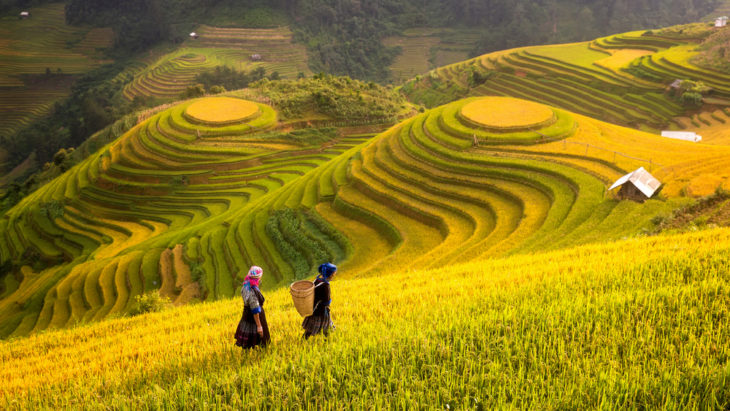
Source: shutterstock.com
Phu Quoc
Phu Quoc is veritably Vietnam’s best-looking island. Located right in the Gulf of Thailand, Phu Quoc is a perfect menagerie of white-sand, swaying palm trees, and sleepy villages. The island is well renowned the world over for its fish sauce, which may not be glowing accolades for the typical Western tourists, but when you consider that the east use fish sauce like the west use salt and pepper, it’s very impressive. Like everywhere else in Vietnam, increasing tourism numbers has meant sweeping investment, with all of the good and bad that that brings. However, it is still extremely easy to travel off the beaten track and to discover a taste of this beautiful, fascinating island.
Whilst flying is certainly the easiest option, with flights operating from Ho Chi Minh direct to Phu Quoc, an hour away, it is also possible to take the bus and a boat. Please note, this is not always the cheaper option, and boats can be unreliable. Take a bus from Ho Chi Minh to Ha Tien or Rach Gia, which will take around six hours and cost around 200,000VND. From either locale, you’ll be able to take a boat (between 1.5-2.5 hours) to Phu Quoc, and the ticket will cost you around 300,000 VND.
Travel Tips
Budget the time well for each destination. Vietnam is a long country and whilst it is very accessible due to its large network of trains and buses, distances between places can take some time. However, the country’s long, thin geography is also a blessing, as most towns and places of interest are situated not far from the coast, which is serviced by one long and efficient train line, with many others adjoining. Therefore (although we wouldn’t recommend it), it’s possible to get a train from Ho Chi Minh City, all the way to Sapa in the north, with only one change. However, we’d recommend getting off and enjoying the many beautiful stops on the way!
Vietnam is wildly inexpensive, even compared with its Southeast Asian neighbors. The currency, Vietnamese Dong (VND) can be a little confusing, however. The largest denomination is 500,000VND or around 21.5USD, and the smallest you’ll find is 1,000VND, or 0.04USD! Beers on the street can be as little as 5,000VND, and a bowl of pho will be around 30,000VND. Taxis and occasionally street vendors may take advantage of new tourists, so look at your notes carefully when you pay and download an app like xe.com that can be used offline on your phone.
Most hotels will accept either VND or USD, however, smaller businesses will only accept VND. In the big cities, there are a few ATM’s dotted around, however, it is always advised to take out enough cash before you start each day, as they can be elusive, and it is still relatively unlikely for the average business to take cards.
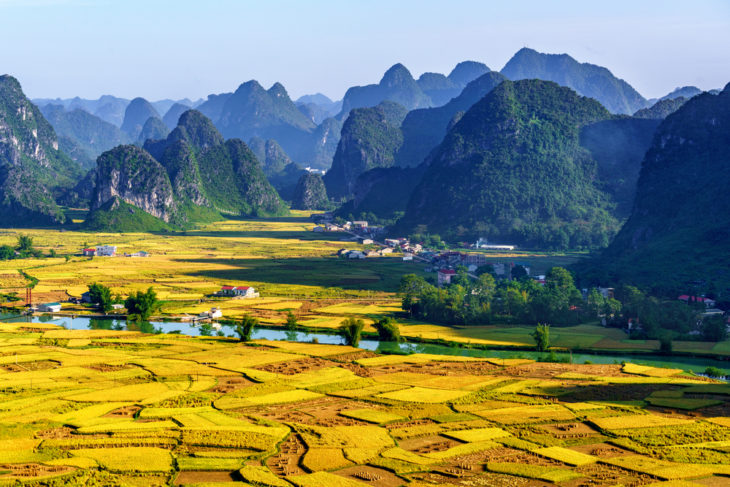
Source: shutterstock.com
Organized Tours
Like everything else in Vietnam, many, many guided tour options are broad and diverse, so we’ve narrowed down the best of the best for you to book on the famous Tripadvisor’s platform Viator or local agency like vietnamtours.com.
Purchasing Tickets
Booking flights is straightforward; just use the same search sites that you would at home, such as skyscanner or kayak.
For buses, trains and ferries, booking at travel agents is easy and reliable, however, you can expect to pay more than you need to. Vietnam is modernizing, and you can book most tickets online. Baolau is one of the best services for booking and buying the train, bus, ferry tickets for Vietnam, Cambodia and Laos, whilst 12go is another safe and reliable bet.
If this doesn’t work, going to the local train or bus station will. Be prepared to bring cash and your passport to make the booking, and patience is key; the Vietnamese don’t have the same queuing culture that we have in the west.
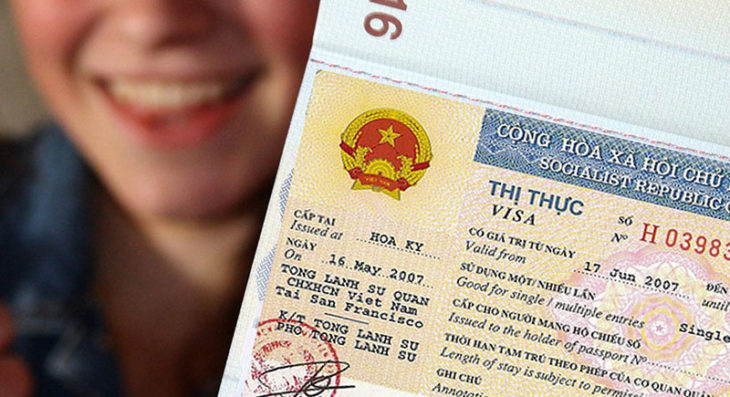
Source: Vietnam-visa.com
Visa Information
At the time of entering Vietnam, your passport must have at least six months of validity. Around 24 countries are eligible for visa-free travel to Vietnam (source), but it is advised to be certain of the duration and conditions before you arrive. Much of Europe, Japan and South Korea get 15 days visa-free entry, whereas Southeast Asian countries like Singapore, Thailand, Malaysia can get a 30-day visa.
To apply for a visa to Vietnam, you will need:
1. Application form with 2 passports sized photos.
2. Cash in USD or VND to pay for the visa fee. The price will depend on what visa you are applying for.
3. A pre-approved invitation letter, completed.
Usually, tourist visas granted for one month from the proposed date of entry. However, three-month tourist visas are also common. Visas can usually be extended for another month at extra cost and the most sure-fire method of doing this is via a Vietnamese travel agent.
